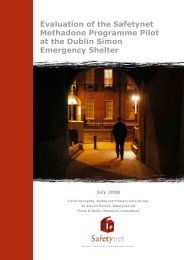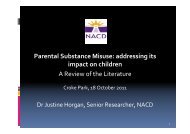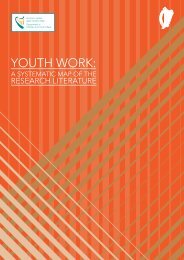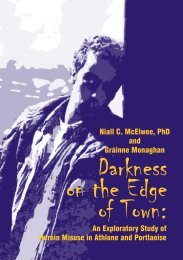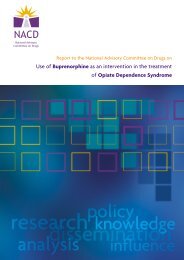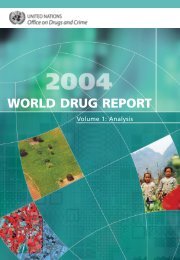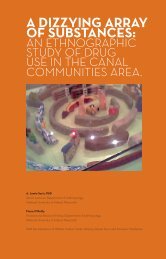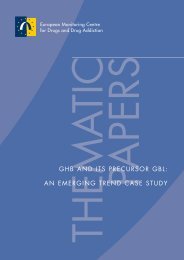Crack cocaine in the Dublin region - Health Research Board
Crack cocaine in the Dublin region - Health Research Board
Crack cocaine in the Dublin region - Health Research Board
You also want an ePaper? Increase the reach of your titles
YUMPU automatically turns print PDFs into web optimized ePapers that Google loves.
MedicationsA number of studies have concentrated on f<strong>in</strong>d<strong>in</strong>g a medic<strong>in</strong>e to alleviate depressionassociated with <strong>coca<strong>in</strong>e</strong> use and to reduce <strong>coca<strong>in</strong>e</strong> crav<strong>in</strong>g. Lima and colleagues(2003) completed a systematic review of 18 randomised control trials on <strong>the</strong> use ofantidepressants <strong>in</strong> treat<strong>in</strong>g <strong>coca<strong>in</strong>e</strong> dependence. The authors found that trials hadnot shown that antidepressants helped reduce <strong>coca<strong>in</strong>e</strong> dependence, although thismight have been partly because many people stopped us<strong>in</strong>g <strong>the</strong> antidepressants tooearly. More people might have benefited if <strong>the</strong>y had cont<strong>in</strong>ued to use antidepressantsfor an appropriate period of time. The f<strong>in</strong>d<strong>in</strong>gs and recommendations were similar for<strong>coca<strong>in</strong>e</strong> users who were also dependent on hero<strong>in</strong> or were on methadone programmes.Individuals attend<strong>in</strong>g treatment programmes may benefit from supervised consumptionof anti-depressants and this approach should be tested us<strong>in</strong>g an appropriate researchmethod.Because chronic use of <strong>coca<strong>in</strong>e</strong> decreases dopam<strong>in</strong>e concentrations <strong>in</strong> <strong>the</strong> bra<strong>in</strong>, itwas thought that pharmacological treatment that controlled dopam<strong>in</strong>e levels could<strong>the</strong>oretically reduce <strong>the</strong>se symptoms and contribute to a more successful <strong>the</strong>rapeuticapproach. Soares and colleagues (2003) evaluated <strong>the</strong> efficacy and acceptability ofdopam<strong>in</strong>e agonists for treat<strong>in</strong>g <strong>coca<strong>in</strong>e</strong> dependence through a systematic review of17 studies. The authors reported that dopam<strong>in</strong>e agonists had been used for reduc<strong>in</strong>g<strong>the</strong> symptoms that patients experienced dur<strong>in</strong>g <strong>the</strong> <strong>in</strong>itial period of abst<strong>in</strong>ence from<strong>coca<strong>in</strong>e</strong>. This review of trials found that <strong>the</strong> evidence of success was not adequate tosupport <strong>the</strong> use of dopam<strong>in</strong>e agonists as a treatment for <strong>coca<strong>in</strong>e</strong> dependence.The anti-convulsant carbamazep<strong>in</strong>e (a tricyclic medication that is widely used totreat a variety of neurological and psychiatric disorders) has been used for treatmentof <strong>coca<strong>in</strong>e</strong> dependence. Lima-Reisser and colleagues (2002) exam<strong>in</strong>ed whe<strong>the</strong>rcarbamazep<strong>in</strong>e was effective <strong>in</strong> <strong>the</strong> treatment of <strong>coca<strong>in</strong>e</strong> dependence through asystematic review of five studies. The review of trials found that carbamazep<strong>in</strong>e hadnot been shown to help reduce <strong>coca<strong>in</strong>e</strong> dependence. The drop-out rate from treatmentwas high, adverse effects were common, and <strong>the</strong>re was no significant fall <strong>in</strong> <strong>the</strong>participants’ <strong>coca<strong>in</strong>e</strong> use.Silva de Lima and colleagues (2002) reviewed <strong>the</strong> efficacy of pharmaco<strong>the</strong>rapy <strong>in</strong>treat<strong>in</strong>g <strong>coca<strong>in</strong>e</strong> dependence. The drug treatments <strong>in</strong>cluded <strong>in</strong> <strong>the</strong> trials were grouped<strong>in</strong>to <strong>the</strong> follow<strong>in</strong>g categories: antidepressants, carbamazep<strong>in</strong>e, dopam<strong>in</strong>e agonists,and miscellaneous o<strong>the</strong>r drugs. The miscellaneous treatments <strong>in</strong>cluded naltrexone,maz<strong>in</strong>dol, lithium, disulfiram, phenyto<strong>in</strong>, nimodip<strong>in</strong>e, lithium carbonate, NeuRecover-SA and risperidone. The effects of <strong>the</strong>se drugs were compared with each o<strong>the</strong>r or witha placebo. Seven studies were <strong>in</strong>cluded <strong>in</strong> <strong>the</strong> review. The authors concluded that <strong>the</strong>rewas no current evidence to support <strong>the</strong> cl<strong>in</strong>ical use of most of <strong>the</strong>se drugs, <strong>in</strong>clud<strong>in</strong>gdisulfiram, <strong>in</strong> <strong>the</strong> treatment of <strong>coca<strong>in</strong>e</strong> dependence.130 <strong>Crack</strong> <strong>coca<strong>in</strong>e</strong> <strong>in</strong> <strong>the</strong> Dubl<strong>in</strong> <strong>region</strong>: an evidence base for a crack <strong>coca<strong>in</strong>e</strong> strategy




